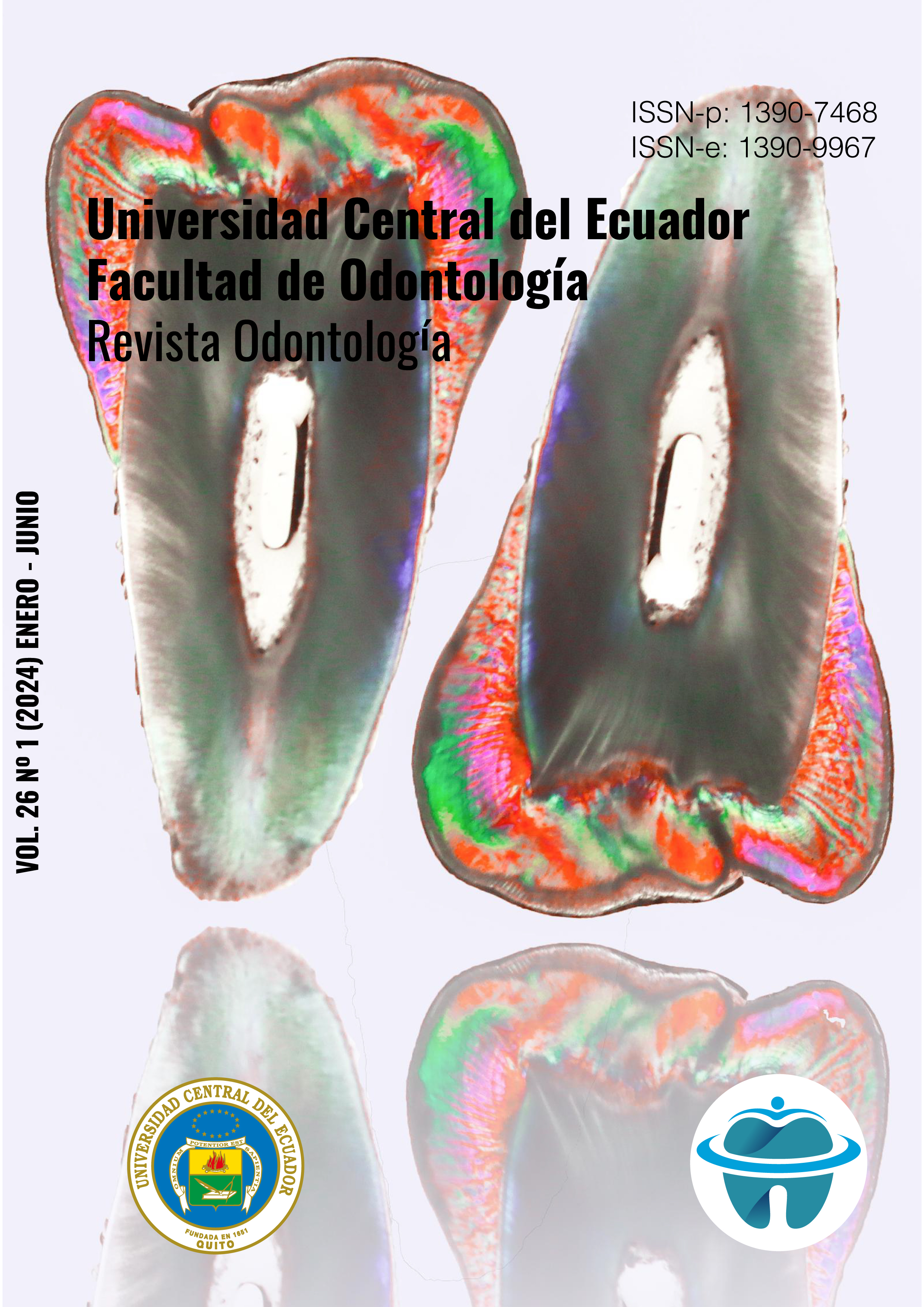Occlusal asymmetry in school children served in a pediatric dentistry clinic
DOI:
https://doi.org/10.29166/odontologia.vol26.n1.2024-e3096Keywords:
dental occlusion, occlusal asymmetry, epidemiology, malocclusionAbstract
Objective: Determine the prevalence of occlusal asymmetry in schoolchildren aged 5 to 10 years, who attended the Pediatric Department of the Faculty of Dentistry of Universidad Central del Ecuador during the period 2019-2020. Materials and methods: An intraoral and extraoral clinical evaluation was performed on 297 patients. The information was compiled in a table designed for this research Statistics: The results were statistically analyzed using the SPSS program applying the Chi square test with a reliability level of 95%. Results: The asymmetric canine relationship occurred in a lower percentage compared to the asymmetric molar relationship. There is an asymmetric canine relationship with more prevalence in the mixed dentition than in the primary dentition. Regarding the asymmetric molar relationship, it was evidenced less frequently in the primary dentition than in the mixed dentition. The dental midline coincided in half of the patients analyzed. The facial midline coincides in most cases. Conclusion: The prevalence of canine asymmetric relationship in the participants was lower than the molar asymmetric relationship, with a higher percentage in the mixed dentition. Most participants had a coincident dental and facial midline.
Downloads
References
Murillo IK. ASIMETRÍA MANDIBULAR SEGÚN THILANDER EN LA POBLACIÓN ECUATORIANA. RIOBAMBA, 2020-2021. Riobamba: Universidad Nacional de Chimborazo.
Izquierdo AR. LA MALOCLUSIÓN DENTAL Y SU RELACIÓN CON LA POSTURA CORPORAL EN NIÑOS Y ADOLESCENTES DE LA PARROQUIA LA ASUNCIÓN, BOLÍVAR. Ambato: Universidad Técnica de Ambato.
Mishra A, Tandón R, Azam A, Singh K, Chandra D, Mishra SV. Asimetría facial : una revisión. IP Rev India Ortod e Investig Dentofac. 2021; 7(2): p. 114-22.
Negrete L. FRECUENCIA DE ASIMETRÍAS MANDIBULARES EN RADIOGRAFÍAS PANORÁMICAS EN PACIENTES DE 18 A 40 AÑOS, QUE ACUDEN A UN CENTRO DE IMÁGENES AÑO 2019 – CAJAMARCA. UPAGU.
Neyra CE. Frecuencia de asimetría condilar y mandibular en radiografías panorámicas mediante dos técnicas radiográficas. Universidad Nacional Mayor de San Marcos.
Arora K, Bansal R, Mohapatra S, Pareek S. Review and Classification Update: Unilateral condylar hyperplasia. BMJ Case Rep. 2019; 12(2).
Yu J, Yang T, Dai J, Wang X. Histopathological features of condylar hyperplasia and condylar Osteochondroma: A comparison study. Orphanet J Rare Dis. 2019; 14(1): p. 1-12.
García E, Lasso D. Prevalencia de asimetrías mandibulares en pacientes que acudieron al Centro Radiológico de la Facultad de Odontología de la Universidad de Cuenca. Universidad de Cuenca.
Ames G. Escuela Académico Profesional de Odontología Prevalencia de asimetrías mandibulares en pacientes atendidos en el Centro Radiológico; 2021.
Fernández A, Burgueño L, Diéguez M. Influence of the mandibular position on various postural anatomical segments: CRANIO; 2021.
González S, Llanes M, Batista N, Pedroso L. Relación entre oclusión dentaria y postura cráneo-cervical en niños con maloclusiones clase II y III. Rev Médica Electrónica. 2019; 41(1): p. 63-77.
Pérez A, Coheña M, Cabrera M. Influence of Dental Malocclusion on Body Posture and Foot Posture in Children: A Cross-Sectional Study. Healthcare. 2020; 8(4): p. 485.
Sofyanti E, Boel T, Sihombing A. The correlation between back posture and sagittal jaw position in adult orthodontic patients. J Taibah Univ Med Sci. 2021; 16(1): p. 63-9.
Zurita J, Ayuso R, Cuartero M. Relationship between Unilateral Posterior Crossbite and Human Static Body Posture. Int J Environ Res Public Health. 2020; 17(15): p. 5303.
Michalakis K, Kamalakidis S, Pissiotis A, Hirayama H. The Effect of Clenching and Occlusal Instability on Body Weight Distribution, Assessed by a Postural Platform. BioMed Res Int. 2019; 20(8): p. 541.
Cabrera M, Domínguez A, Pabón M. Dental Malocclusion and Its Relation to the Podal System. Front Pediatr. 2022; 10(2).
Sambataro S, Bocchieri S, Cervino G. Correlations between Malocclusion and Postural Anomalies in Children with Mixed Dentition. J Funct Morphol Kinesiol. 2019; 4(3): p. 45.
Sandoval C, Díaz A, Manríquez G. Relationship between craniocervical posture and skeletal class: A statistical multivariate approach for studying Class II and Class III malocclusions. CRANIO. 2021; 39(2): p. 133-40.
Khan M, Raza S. Coincidence of Dental Midline with Facial Midline in a Sample of Pakistani Population. J Coll Physicians Surg Pak. 2019; 29(3): p. 210.
Klostermann I, Kirschneck C, Lippold C, Chhatwani S. Relationship between l posture and early orthodontic treatment in children. Head Face Med. 2021; 17(1): p. 4.
Published
How to Cite
Issue
Section
License
Copyright (c) 2024 Ricardo Alexander Erazo Carrera, David Andrés Almeida Reyes, Nilda Eugenia Navarrete Angulo

This work is licensed under a Creative Commons Attribution-NonCommercial-NoDerivatives 4.0 International License.


